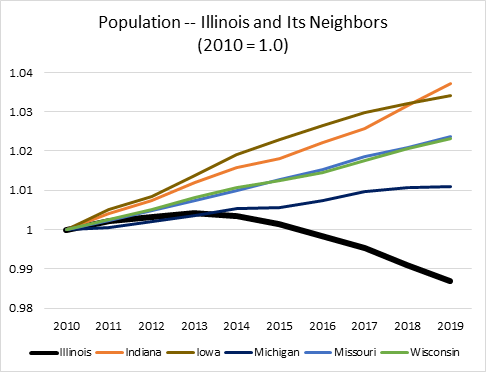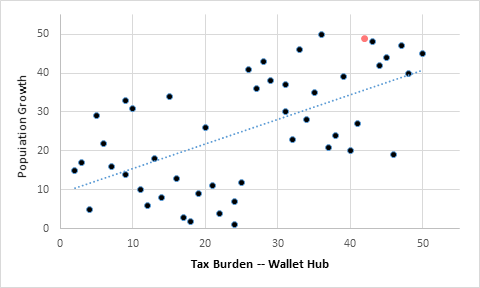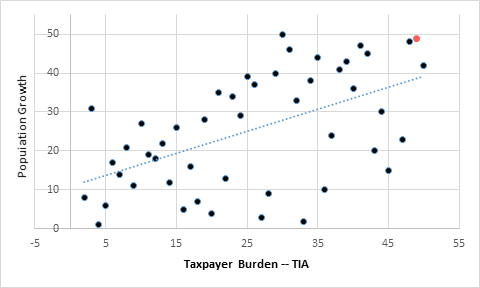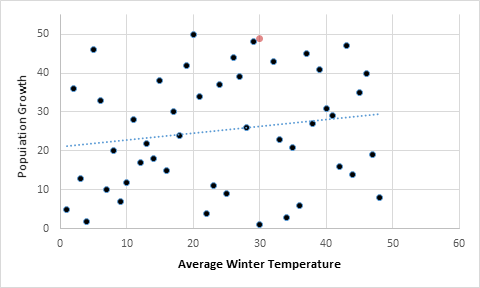Late last year, two government reports added to the growing body of evidence that mismanagement of government finances have led to significant outmigration from the Land of Lincoln.
The annual population estimates from the U.S. Census Bureau showed Illinois’ population declined for the sixth consecutive year in 2019. And a report from the Internal Revenue Service (with more thorough data on people and money but only updated through 2018) showed large-scale net out-migration of people and taxable income.
As more than a few observers have noted, it ain’t just the weather. Here’s a look at population in Illinois and its neighboring (cold) states since 2010. (The chart is indexed to 2010 = 1.0 to make the states the same size, helping the comparison)

Looking across the 50 states, the tendency is the warmer the state (especially in winter), the better the population growth. But that tendency is not nearly as strong as other variables of interest, including measures of government finances.
For example, WalletHub computes and reports an annual ranking of the 50 states based on their measure of state “tax burden.” WalletHub adds property, sales, and income tax revenue for the states, relating them to overall state personal income. On that basis, Illinois has ranked in the bottom 10 states for tax burden (based on how high) in the last three years. And looking across the 50 states, the 10 states with the lowest population growth in the last decade had much lower-than-average rankings on WalletHub’s tax burden measure compared to an average ranking for the 10 states with the best population growth.
Here’s a look at comparing state population growth rankings to their rankings on WalletHub’s “tax burden” measure. The states at the upper right (including the red dot, Illinois) have both low population growth and high (worse) WalletHub tax burdens.

“You can pay me now,” or” you can pay me later” were the punch lines in a 1970s commercial for Fram Oil Filters. So it goes, after a fashion, with government spending and taxes. Despite advertised balanced budget requirements in 49 of the 50 states, many states have run up huge debts anyway. They did so by running up the credit cards in ways that, until recently, never showed up as debt on the balance sheet. Accrual expenses ran far ahead of revenue – and they didn’t tax their citizens enough, given what they were spending (including expenses arising with distributing unfunded pension promises).
The result is that it isn’t just current taxpayers facing high tax “burdens.” Taxpayers in states like Illinois aren’t just threatened by current tax bills. The overall measure of state fiscal health reflected in Truth in Accounting’s (TIA) “Taxpayer Burden” accounts for the impact of debt on future taxpayer resources – for the taxpayers that choose to stick around, anyway.
Here’s a look at states using TIA’s “Taxpayer Burden” rankings, comparing them to population result. The same tendency holds – the higher the “Taxpayer Burden,” the lower the population growth. Again, Illinois is that little red dot in the picture below, ranking 2nd to last both on population growth and TIA’s Taxpayer Burden.

Compare the results for both WalletHub’s “Tax Burden” and TIA’s “Taxpayer Burden” to the chart below, which compares population growth to the “Average Winter Temperature” variable we include in our State Data Lab (soon to be “Data-Z”) website. The relationship for cold winters and population growth isn’t nearly as strong as it is for the government financial condition rankings.

Growing awareness of the “Illinois Exodus” isn’t restricted to right-wing think tanks or selected newspapers. Real estate professionals are also paying attention. And for good reason.
The chart below shows rankings of the states based on population growth in the last decade, comparing them to rankings on home price appreciation (using reports from the Federal Housing Finance Agency) since 2010. Once again, Illinois is that little red dot up there at the upper right.

The better the population growth, the stronger the home price appreciation. And as current and future taxpayers make their migration decisions, home prices (and property tax revenues) react – that’s how it appears.
A recent article at “Accounting Coach” was titled “Is Income Tax an Expense or a Liability?” For taxpayers in Illinois and similarly-situated states like Connecticut, New Jersey and New York, the best answer could simply be “Yes.”
Unless they move.

